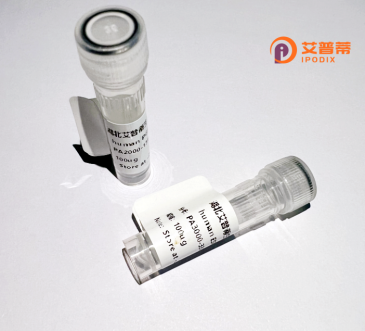
| 纯度 | >90%SDS-PAGE. |
| 种属 | Human |
| 靶点 | BIRC4BP |
| Uniprot No | Q6GPH4 |
| 内毒素 | < 0.01EU/μg |
| 表达宿主 | E.coli |
| 表达区间 | 1-301aa |
| 氨基酸序列 | MEGDFSVCRN CKRHVVSANF TLHEAYCLRF LVLCPECEEP VPKETMEEHC KLEHQQVGCT MCQQSMQKSS LEFHKANECQ ERPVECKFCK LDMQLSKLEL HESYCGSRTE LCQGCGQFIM HRMLAQHRDV CRSEQAQLGK GERISAPERE IYCHYCNQMI PENKYFHHMG KCCPDSEFKK HFPVGNPEIL PSSLPSQAAE NQTSTMEKDV RPKTRSINRF PLHSESSSKK APRSKNKTLD PLLMSEPKPR TSSPRGDKAA YDILRRCSQC GILLPLPILN QHQEKCRWLA SSKGKQVRNF S |
| 分子量 | 34.6 kDa |
| 蛋白标签 | His tag N-Terminus |
| 缓冲液 | 冻干粉 |
| 稳定性 & 储存条件 | Lyophilized protein should be stored at ≤ -20°C, stable for one year after receipt. Reconstituted protein solution can be stored at 2-8°C for 2-7 days. Aliquots of reconstituted samples are stable at ≤ -20°C for 3 months. |
| 复溶 | Always centrifuge tubes before opening.Do not mix by vortex or pipetting. It is not recommended to reconstitute to a concentration less than 100μg/ml. Dissolve the lyophilized protein in distilled water. Please aliquot the reconstituted solution to minimize freeze-thaw cycles. |
以下是关于重组人BIRC4(XIAP)蛋白的3篇经典参考文献,简要概括作者及研究内容:
---
1. **"X-linked IAP is a direct inhibitor of cell-death proteases"**
*Duckett, C. S., et al. (1996). Nature, 379(6563).*
该研究首次克隆了XIAP(BIRC4),证明其通过直接抑制caspase-3和caspase-7的活性来调控细胞凋亡,为凋亡抑制机制提供了关键依据。
2. **"Mechanism of XIAP-mediated inhibition of caspase-9"**
*Shiozaki, E. N., et al. (2003). Molecular Cell, 11(2).*
作者解析了XIAP的BIR3结构域与caspase-9的结合机制,揭示了XIAP通过空间位阻阻止caspase-9活化,从而抑制凋亡信号通路的分子细节。
3. **"Structural basis for binding of Smac/DIABLO to XIAP"**
*Wu, G., et al. (2000). Nature, 408(6815).*
该研究通过晶体结构分析,阐明线粒体蛋白Smac/DIABLO与XIAP结合的作用机制,为靶向XIAP的癌症治疗策略提供了结构基础。
---
以上文献涵盖了XIAP的功能机制、结构互作及潜在治疗应用,均为该领域的奠基性研究。如需具体期刊页码或更多文献,建议通过PubMed或Web of Science进一步检索。
BIRC4BP, also known as XIAP-binding protein 1 (XAF1), is a recombinant human protein involved in regulating apoptosis and cellular stress responses. It interacts with X-linked inhibitor of apoptosis protein (XIAP/BIRC4), a key anti-apoptotic molecule that suppresses caspase activity. Unlike XIAP, BIRC4BP/XAF1 functions as a pro-apoptotic factor by counteracting XIAP-mediated caspase inhibition, thereby promoting programmed cell death. Structurally, it contains seven zinc finger domains and a conserved XIAP-binding motif, enabling its antagonistic role.
This protein is expressed in various tissues and plays a role in immune regulation, tumor suppression, and responses to DNA damage. Dysregulation of BIRC4BP/XAF1 has been linked to cancer progression, as reduced levels are observed in certain malignancies, correlating with poor prognosis and chemotherapy resistance. Recombinant forms of BIRC4BP are produced using expression systems like E. coli or mammalian cells for research and therapeutic exploration. Studies focus on its potential in cancer therapy, either alone or combined with XIAP inhibitors, to restore apoptosis in malignant cells. Additionally, it is investigated in inflammatory and neurodegenerative diseases for modulating cell survival pathways. Its dual role in apoptosis and cellular stress makes it a critical target for understanding disease mechanisms and developing targeted treatments.
×